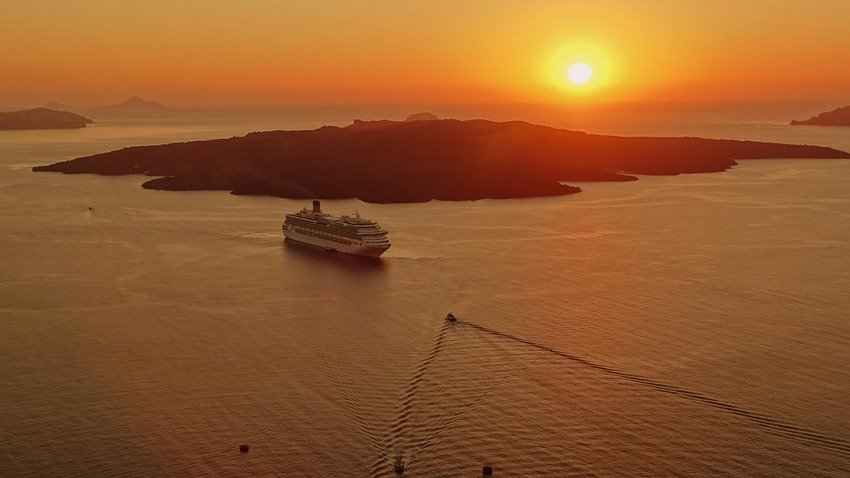Travel Guides & Articles
Now Croatia Unifies Australia, and India to Join the Cruise Revolution: Sustainable Travel and New Ports Offer Unforgettable Experiences

Tuesday, July 22, 2025
The allure of stepping off a cruise ship and exploring a new port is unparalleled. Whether travelers are drawn to vibrant cultural experiences, tantalizing culinary offerings, exhilarating hikes, or peaceful paddling adventures, these excursions offer a unique way to experience new destinations. However, with the rising concerns of over-tourism in some of Europe’s busiest cruise ports, it is reassuring to see a number of destinations working hard to expand their infrastructure to accommodate the increasing demand for cruise tourism in a more sustainable way. One such example is the city of Newcastle in New South Wales, Australia, where efforts are underway to develop a robust cruise market over the next decade. With the Port Authority’s plans for expanding the cruise industry into Newcastle Harbour, the city is poised to become a prominent player in the Australian cruise market.
Newcastle’s Strategic Efforts to Capture the Cruise Market
The Port Authority of New South Wales recently announced plans to hire a dedicated cruise coordinator who will work closely with cruise lines to expand their itineraries, enabling passengers to explore the best of the Hunter and Central Coast regions. This initiative is a promising step toward diversifying the experiences available to cruise passengers, offering them the chance to enjoy winery visits, historic architecture walks, and breathtaking coastal national park hikes. These additions not only elevate the traveler experience but also provide significant economic opportunities for local businesses and communities. As Port Authority of NSW CEO, John McKenna, pointed out, the expansion of the cruise market is beneficial for both the tourists, who will be provided with unforgettable experiences, and the local economy, which stands to gain from the increased tourism spending.
By enhancing Newcastle’s offerings as a cruise destination, the city is positioning itself as a key player in the global cruise industry, helping to ease the pressures felt by more overcrowded cruise ports while simultaneously capitalizing on the economic benefits that cruising brings. This strategy reflects a growing trend toward expanding cruise options to lesser-known yet equally captivating destinations that can provide rich, immersive travel experiences without contributing to the negative aspects of overtourism.
Broome’s Push to Become an International Cruise Gateway
On the west coast of Australia, the city of Broome in the Kimberley region is also making significant strides in establishing itself as a vital hub for cruise tourism. With the West Australian government pledging $500,000 toward the development of a new international passenger terminal, Broome is on track to become an essential gateway for cruise ships sailing from northern Australia. Joel Katz, from the Cruise Lines International Association (CLIA), noted that an international terminal in Broome will open up new possibilities for international cruising in Western Australia, making it a key first port of call for ships arriving from international destinations.
Broome’s entry into the cruise market is an important step toward spreading cruise tourism beyond the well-known, heavily visited cities. The establishment of Broome as a port for international cruises will not only boost the local economy but also help diversify Australia’s cruise industry. With stunning beaches, unique cultural experiences, and proximity to world-renowned natural wonders such as the Bungle Bungles, Broome offers an experience that is distinctly different from Australia’s more traditional cruise destinations. As such, Broome is primed to attract a new wave of travelers seeking something off the beaten path.
India’s Growing Cruise Infrastructure: Expanding Ports and New Opportunities
The cruise industry is also gaining momentum in India, with major developments in the country’s port infrastructure aimed at catering to both domestic and international cruise passengers. The International Cruise Terminal Station in Mumbai, which opened in April, is designed to accommodate 1,000 ships and 1.2 million passengers annually by 2030. This ambitious project is part of India’s broader efforts to establish itself as a prominent player in the global cruise tourism market. Additionally, the recent opening of the Visakhapatnam International Cruise Terminal on India’s east coast marks another milestone in the country’s growing cruise offerings.
This new terminal in Visakhapatnam now offers cruise services connecting the city to Chennai and Puducherry, and there are plans to expand the routes to include international destinations such as Colombo, Thailand, Malaysia, and Singapore. The Indian government’s efforts to build modern, high-capacity terminals reflect a strategic push to capture the growing cruise market, both for inbound international travelers and for domestic tourism. As global tourism continues to evolve, India’s emerging cruise infrastructure will provide new opportunities for travelers to explore the country’s rich cultural heritage, stunning coastline, and vibrant cities.
The Economic Benefits of Expanding Cruise Tourism
The economic benefits of expanding cruise tourism are substantial. The Cruise Lines International Association (CLIA) and the Australian Cruise Association estimate that each cruise passenger spends, on average, $455 per day onshore. When ships start or end their voyages at a port, the spending often increases, as hotel stays, meals, and local excursions are factored into the overall tourism spend. This makes the development of new cruise ports a sound financial decision for any destination looking to stimulate its economy and attract international travelers.
In addition to direct spending by cruise passengers, the establishment of new cruise ports also creates jobs in various sectors, including transportation, hospitality, retail, and local services. This influx of visitors can significantly improve the livelihoods of those working in tourism-related industries and offer opportunities for local businesses to expand and grow.
For example, the development of new cruise terminals can help distribute the influx of visitors more evenly across the country, reducing overcrowding in popular locations. By creating more cruise hubs in different regions, the pressure on overburdened tourist destinations can be alleviated, and visitors can be encouraged to explore less-visited but equally stunning areas. This is particularly important in countries like Croatia, where popular cruise ports such as Dubrovnik have become overcrowded, impacting both the local community and the visitor experience.
A Shift Toward Smaller, Less Crowded Ports: Šibenik, Croatia
As the demand for cruise tourism grows, some smaller, lesser-known ports are capitalizing on the opportunity to attract cruise ships. One such destination is Šibenik, a medieval town on the Adriatic coast of Croatia. Historically overshadowed by larger cities along the Dalmatian Coast, Šibenik is positioning itself as a new cruise hub for smaller ships, offering an alternative to the overcrowded streets of Dubrovnik. Starting in 2026, small-ship operator Unforgettable Croatia will offer 36 cruises that embark and disembark from Šibenik, introducing travelers to the town’s rich history and unique charm.
Šibenik’s relatively small size and off-the-beaten-path location provide an antidote to the pressures of overtourism, offering a more intimate and less crowded experience for those looking to explore Croatia’s coastal beauty without the overwhelming crowds. As more cruise lines look to reduce congestion at popular ports, smaller destinations like Šibenik are emerging as viable alternatives that can offer a more serene and authentic experience for visitors.
A Balanced Approach to Cruise Tourism
The growing trend of expanding cruise offerings into less-visited destinations and improving port infrastructure in popular cities reflects a more sustainable approach to tourism. By diversifying the destinations where cruises dock and spreading out the volume of visitors, local communities can reap the economic benefits of tourism without experiencing the negative side effects of overcrowding. This strategy not only benefits passengers, who get to explore new places with a more authentic experience, but also helps preserve the cultural and environmental integrity of major tourist cities.
Cruise lines, port authorities, and local governments all have a role to play in ensuring that tourism remains a sustainable driver of economic growth. By investing in infrastructure, promoting lesser-known ports, and focusing on providing unique cultural and natural experiences, the cruise industry can continue to thrive while mitigating the challenges of overtourism.
Conclusion: The Future of Cruise Tourism
The expansion of cruise tourism to new destinations and the development of modern, sustainable port infrastructure mark a significant shift in how the global tourism industry operates. By focusing on cultural authenticity and providing more diversified travel experiences, the cruise industry has the potential to contribute positively to both local economies and the environment. As seen in places like Puerto Rico, Broome, and Šibenik, the future of cruise tourism lies in offering passengers memorable experiences in destinations that are both accessible and sustainable. As more ports around the world embrace this approach, the cruise tourism sector is poised to continue its growth, benefiting both travelers and the communities they visit.
Tags: Broome Australia, central coast, Cruise Experiences, cruise tourism, cruise travel expansion, cultural tourism, Eco-friendly tourism, Global cruise market, Hunter Coast, India cruise infrastructure, international cruising, new cruise ports, Newcastle Australia, Over-tourism, port expansion, Šibenik Croatia, sustainable travel, tourism development, tourism economy
Travel Guides & Articles
Spirit Airlines Is Struggling, and Rivals Smell Blood

The airline industry is betting against Spirit Airlines.
Spirit’s biggest aircraft lessor last week told the carrier it was terminating lease agreements for some of its planes, helping tip the struggling discounter into its second bankruptcy in less than a year. Now, rival airlines are getting in position to go after the budget airline’s customers.
United Airlines, whose chief executive has predicted since last year that Spirit would eventually go under, is preparing to backfill the void that would be left if Spirit goes out of business by the end of this year. It is adding flights starting in January from Spirit strongholds such as Las Vegas as well as Orlando and Fort Lauderdale, Fla.
“If Spirit suddenly goes out of business it will be incredibly disruptive, so we’re adding these flights to give their customers other options if they want or need them,” said Patrick Quayle, United’s head of network planning and alliances.
Frontier, which is gunning for Spirit’s position as the largest U.S. ultradiscounter, has seized on Spirit’s pullback, announcing plans to add service along several routes Spirit serves.
“We want to be America’s low-fare airline,” said Frontier Chief Executive Barry Biffle. “And we see an opportunity.”
Spirit, which filed for chapter 11 bankruptcy last week, has assured customers they can continue to book future flights and use their tickets. Chairman Robert Milton said in a recent interview the airline has no intention of liquidating: “It needs its costs restructured and to get its mojo back.”
Spirit for years played the role of an airline industry maverick, charging ultralow fares with fees for almost everything.
A Spirit spokesman on Thursday described United’s plans as “wishful thinking” from an airline that wants to drive a low-cost competitor out of business in order to charge more.
“While we appreciate the obsession certain airline executives have with us, we’re focused on competing and running a great operation,” he said.
But even a weakened Spirit is good news for competitors, which stand to benefit from reduced supply of seats.
In years past, Spirit has played the role of an industry maverick. It was willing to fly its bright yellow planes into big cities and go head-to-head with the legacy airlines. Its nickel-and-dime approach to sales—charging bargain basement fares with fees for almost everything—sometimes annoyed customers. But it also forced competitors to lower fares, and in many cases, adopt similar practices.
Now Spirit plans to shrink its fleet and retrench to key cities such as Orlando, Fort Lauderdale and Detroit. It announced this week that it is pulling out of 11 cities and scrapping plans to add service to one more—about 4.5% of its planned flights.
A three-year saga of failed mergers, changing postpandemic travel patterns, and new competitive weapons deployed by big airlines brought Spirit to this point. Spirit’s losses since the beginning of 2020 have more than wiped out all the profits it made since 2006, when it shifted to embrace the ultradiscount model.
Struggling to find its footing after a federal judge last year struck down a $3.8 billion acquisition by JetBlue Airways, Spirit filed for its first bankruptcy in November. But it didn’t seek to use the power of chapter 11 to renegotiate contracts with aircraft lessors or other obligations, as other airlines have historically done after filing for bankruptcy.
The company opted instead for a quick balance-sheet fix that minimized its time spent under court protection, hoping to avoid a lengthy and expensive process. The earlier bankruptcy only affected Spirit bondholders, which swapped nearly $800 million in debt for equity ownership of the business, while leaving more than $2 billion of debt outstanding.
Spirit recently said it is pulling out of 11 cities and scrapping plans to add service to one more.
“Unfortunately, the industry-wide headwinds that preceded the Prior Chapter 11 Cases did not abate; rather, they intensified,” Chief Financial Officer Fred Cromer wrote in a court filing over the weekend. Instead of the $252 million in profit Spirit had projected for 2025, it reported in August that it had lost more than $256 million since mid-March.
Spirit had started to warn of its dire straits last month and was scrambling to bolster its cash balances. It drew down $275 million on its revolving credit facility and completed a series of sale-leaseback transactions in July and August that brought in approximately $250 million.
Then last week, AerCap, Spirit’s largest lessor, notified the carrier it was terminating leases for 36 planes scheduled for delivery in the coming years, and said Spirit was also in default on more than three dozen planes already in its fleet.
Worried that the disclosure of the notices would panic other creditors, the airline decided it had no choice but to file for chapter 11 bankruptcy protection again.
Spirit denied that it had defaulted on any of the leases. It said it is negotiating with AerCap to resolve the issue and is prepared to litigate the matter. An AerCap representative didn’t respond to requests for comment.
The company is burning through cash fast. Spirit disclosed a projection showing that it expects to burn $179 million for the first month of the bankruptcy case. Cromer said in court papers that the airline is continuing to work with certain bondholders on an agreement that would allow access to “significant additional liquidity.”
Spirit has said this time will be different.
In a bankruptcy court appearance Tuesday, Spirit lawyer Marshall Huebner characterized the recent filing as “really Spirit’s first chapter 11, not its second.” Spirit intends to use the powers of the bankruptcy code to walk away from certain contracts, shrink its aircraft fleet and reduce its operating costs, Huebner said in court.
Once the process is complete, “Spirit will once again be the disruptive maverick that has long challenged—and changed—the U.S. aviation industry,” Cromer wrote.
Write to Alison Sider at alison.sider@wsj.com and Alexander Gladstone at alexander.gladstone@wsj.com
Travel Guides & Articles
Sonali Phogat murder: Court allows 2nd accused to travel abroad for wife’s birthday

The Goa trial court has allowed Sukhwinder Singh, the second accused in the murder of BJP leader and social media influencer Sonali Phogat, to travel abroad to celebrate his wife’s birthday.
The court allowed Singh’s application, but directed him to return to India and be present for the next date of the trial — September 24.
Singh, who was the first accused to have been granted bail, was earlier directed by the court to surrender his passport before the Central Bureau of Investigation (CBI), which is investigating the case and not to travel abroad as one of the conditions of his bail.
Last month Singh had sought permission from the Panaji district and sessions court to travel to Indonesia for two weeks while also undertaking to return back to India by September 23, the day before the next date of hearing.
“In view of the itinerary given by accused No 2, I am of the opinion that permission can be granted to the accused No 2 to travel abroad,” sessions judge Irshad Aga, said.
Singh along with prime accused Sudhir Pal Sangvan are accused in the murder of the BJP leader on August 22. Phogat, died allegedly due to an overdose of an “obnoxious chemical” suspected to be MDMA that was allegedly mixed with a drink and forcibly given to her during an evening out at a nightclub at Anjuna in north Goa.
The case was initially registered as an “unnatural death” after she was declared dead at the St Anthony’s Hospital at Anjuna in Goa, but subsequently registered as murder based on a complaint filed by her brother Rinku Dhaka, who accused Sudhir Sangvan, the prime accused, who was also her personal assistant of being responsible for her death.
Following an uproar, the case was handed over to the CBI.
Earlier, on account of the trial being prolonged, the court had allowed both the accused to travel outside the state (Goa) and visit their native place in Haryana and relaxed the bail condition that stated they were not to leave the state.
Singh submitted that he and his wife intend to travel to Kuta from September 9 to September 13. From Kuta, they will travel to Canggu for four days till September 17 and thereafter, they will travel by road to Uluwatu and stay there till September 22. The accused submitted that they will return to India on September 23.
Travel Guides & Articles
Afghan foreign minister Amir Khan Muttaqi’s India visit called off

The visit was postponed after he could not get a waiver for the trip, they said.
If the visit had taken place, then it would have been the first ministerial visit from Kabul to India after the Taliban seized power in Afghanistan in August 2021.
The UN Security Council had slapped sanctions against all the leading Taliban leaders and they need to secure a waiver for foreign travels.
External Affairs Ministry spokesperson Randhir Jaiswal, when asked at his weekly media briefing about reports of Muttaqi’s proposed visit to India, did not give a direct reply.
“As you are aware, we have longstanding ties with the people of Afghanistan. India continues to support the aspirations and developmental needs of the Afghan people,” he said.”We continue to have engagements with Afghan authorities. If there is an update on this account, we will share it with you,” he said.External Affairs Minister S Jaishankar had phone conversation with Muttaqi on May 15. It was the highest level of contact between New Delhi and Kabul since the Taliban came to power.
India has not yet recognised the Taliban set up and has been pitching for the formation of a truly inclusive government in Kabul.
New Delhi has also been insisting that Afghan soil must not be used for any terrorist activities against any country.
-

 Business1 week ago
Business1 week agoThe Guardian view on Trump and the Fed: independence is no substitute for accountability | Editorial
-
Tools & Platforms4 weeks ago
Building Trust in Military AI Starts with Opening the Black Box – War on the Rocks
-

 Ethics & Policy1 month ago
Ethics & Policy1 month agoSDAIA Supports Saudi Arabia’s Leadership in Shaping Global AI Ethics, Policy, and Research – وكالة الأنباء السعودية
-

 Events & Conferences4 months ago
Events & Conferences4 months agoJourney to 1000 models: Scaling Instagram’s recommendation system
-

 Jobs & Careers2 months ago
Jobs & Careers2 months agoMumbai-based Perplexity Alternative Has 60k+ Users Without Funding
-

 Education2 months ago
Education2 months agoVEX Robotics launches AI-powered classroom robotics system
-

 Podcasts & Talks2 months ago
Podcasts & Talks2 months agoHappy 4th of July! 🎆 Made with Veo 3 in Gemini
-

 Funding & Business2 months ago
Funding & Business2 months agoKayak and Expedia race to build AI travel agents that turn social posts into itineraries
-

 Education2 months ago
Education2 months agoMacron says UK and France have duty to tackle illegal migration ‘with humanity, solidarity and firmness’ – UK politics live | Politics
-

 Podcasts & Talks2 months ago
Podcasts & Talks2 months agoOpenAI 🤝 @teamganassi



















